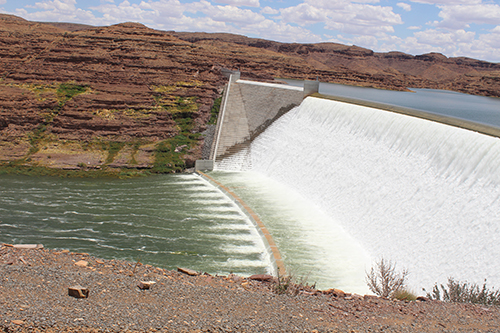Albertina Nakale
Cabinet is expected to consider a public-private partnership proposal towards the development of a 5 000-hectare irrigation scheme outside the overflowing Neckartal Dam, agriculture and water minister Calle Schlettwein said yesterday.
Once implemented, the project is expected to boost food security and economic development in the //Kharas region.
Last year, government announced the envisaged irrigation scheme would produce a valley of green lush lands, where high-value crops like wheat, maize, vegetables and fruits as well as animal fodder could be produced for consumption and export to other markets.
With government unable to afford the implementation of the project on its own, Schlettwein yesterday confirmed the authorities will consider a PPP proposal for the second phase of Namibia’s largest dam project. Schlettwein said the second phase, which has commenced in conjunction with the Public-Private Partnership Unit in the Ministry of Finance, will soon be presented to Cabinet for consideration and approval.
Following good rains in the south of the country, the Neckartal Dam started spilling over for the second year in a row this week. Schlettwein yesterday told New Era the planning phase of the irrigation project has been completed.
However, the government, which initially planned to develop phase two of the Neckartal irrigation project, could no longer do so due to the recent global and national economic headwinds.
“We completed that phase but we had financial problems. It is for these reasons the government decided to implement phase two through the Public-Private Partnership Unit; however, the plan is in existence. We will approach Cabinet for leasing or purchasing these parcels in the scheme. It will be achieved by engaging private capital,” he said.
The government aims to ensure the entire project is under full production to contribute to food security and employment creation.
The dam is located 40km west of the southern town, Keetmanshoop, in the
//Kharas region – and it has a storage volume of 850 million cubic meters of water over a 40 square kilometres area.
Thus far, of the 5 000 hectares that are targeted for agricultural production, 3 800 hectares have been acquired, and efforts are underway to secure the remaining 1 200 hectares.
Schlettwein earlier indicated the agriculture ministry, in conjunction with the PPP Unit in the Ministry of Finance, has initiated the process to operationalise the Neckartal Dam irrigation project.
The process started with the ministry registering the project with the PPP Unit, and by providing a dossier of all relevant documents pertaining to the initiative, such as feasibility studies, environmental impact assessment, detailed design and cost estimates, scoping report and specialised studies.
The minister is hopeful that once the PPP Unit completes screening it for PPP suitability – and with Cabinet approval, the project can be put under production during the 2022/2023 financial year.
According to the latest daily flood bulletin released by the Namibia Hydrological Services yesterday, the water level in the Neckartal Dam stood at 102.9%.
Neckartal Dam started spilling over on Monday, as it is full. Schlettwein clarified the Neckartal is not a flood-risk dam. “The dam overflows into the Fish River. It is not a big overflow. There is no danger or threat to anyone,” he assured.
He, however, cautioned residents in the surrounding of any major dam or river to be alert of any eventuality.
“We were fortunate to receive good rains, but other parts have little or no rain. We hope they also get some rain,” he said.
He also touched on the issue of harvesting water during the rainy season, seeing Namibia is a dry country.
He said most rivers, such as Fish and Omatako, in Namibia, are dammed.
“Most rivers are dammed. We harvest water. There are also many private dams additional to harvest water. In communal areas, we built earth dams. These are some of the projects we have to catch water. We also started to harvest surface water in the Windhoek area to complement underground aquifers. We take dam water and purify it, and put it into the boreholes,” he noted. – anakale@nepc.com.na


